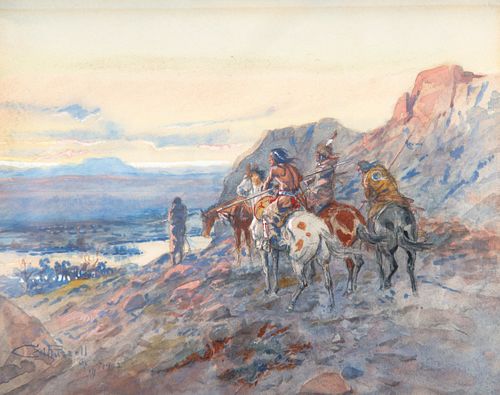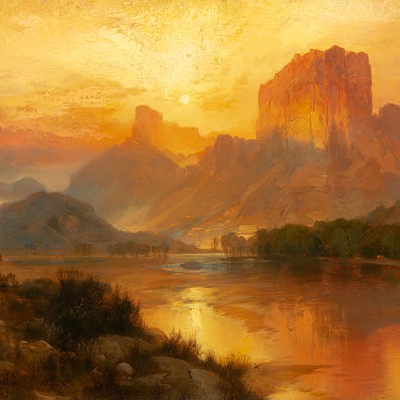Charles M. Russell (1864-1926); Planning the Attack (The Wagon Train) (1902)
Lot 138
About Seller
Coeur d'Alene Art Auction
11944 North Tracey Road
Hayden, ID 83835
United States
Coeur d’Alene Art Auction specializes in the finest classical Western and American Art representing past masters and outstanding contemporary artists. The auction principals have over 100 years of combined experience in selling fine art and have netted their clients over $325 million in the last fif...Read more
Categories
Estimate:
$150,000 - $250,000
Absentee vs Live bid
Two ways to bid:
- Leave a max absentee bid and the platform will bid on your behalf up to your maximum bid during the live auction.
- Bid live during the auction and your bids will be submitted real-time to the auctioneer.
Bid Increments
| Price | Bid Increment |
|---|---|
| $0 | $250 |
| $5,000 | $500 |
| $10,000 | $1,000 |
| $20,000 | $2,500 |
| $50,000 | $5,000 |
| $100,000 | $10,000 |
| $200,000 | $25,000 |
| $500,000 | $50,000 |
| $1,000,000 | $100,000 |
About Auction
By Coeur d'Alene Art Auction
Jul 25, 2020
Set Reminder
2020-07-25 15:00:00
2020-07-25 15:00:00
America/New_York
Bidsquare
Bidsquare : Fine Western & American Art
https://www.bidsquare.com/auctions/coeur-dalene/fine-western-american-art-5263
The 2020 Coeur d'Alene Art Auction to be held July 25 in Reno, Nevada, will feature 264 selections of unparalleled quality in Western paintings and sculpture from historical and contemporary artists such as Charles M. Russell, Henry Farny, Thomas Moran, Edward S. Curtis, Carl Rungius, and more. Coeur d'Alene Art Auction info@cdaartauction.com
The 2020 Coeur d'Alene Art Auction to be held July 25 in Reno, Nevada, will feature 264 selections of unparalleled quality in Western paintings and sculpture from historical and contemporary artists such as Charles M. Russell, Henry Farny, Thomas Moran, Edward S. Curtis, Carl Rungius, and more. Coeur d'Alene Art Auction info@cdaartauction.com
- Lot Description
Charles M. Russell (1864-1926)
Planning the Attack (The Wagon Train) (1902)
watercolor on paper
9 x 12 inches
signed and dated lower left
VERSO
Label, Trigg - C. M. Russell Foundation, Great Falls, MT
Planning the Attack (The Wagon Train) is recorded in the C. M. Russell Catalogue Raisonné as reference number CR.UNL.310.
Rick Stewart wrote, “Almost from the beginning the Plains Indians recognized the threat that the covered wagon caravans represented to their way of life. Sometimes their response was not necessarily to engage in open warfare with the caravans, but to demand tribute from them. ‘Emigrants continually reported that the Indians who came to demand tribute explained also why they were requesting the payments,’ the historian John D. Unrah has written. ‘The native explicitly emphasized that the throngs of overlanders were killing and scaring away buffalo and other wild game, overgrazing prairie grasses, exhausting the small quantity of available timber, and depleting water resources.’ The tribute payments, which could be in specie or provisions were demanded by the Sioux and other tribes whose domains were crossed.
“But conflicts nevertheless occurred because most of the emigrants felt that the Indians had no rights to begin with, and certainly no real ownership of the land over which the wagons passed. In painting his watercolors of this subject, perhaps Russell felt some sort of sympathy with the Indians and their plight; after all, these scenes were painted from the Indian’s point of view not that of the white man. ‘You can’t blame the Indian very much for being sore at the whites, as they killed what nature had provided for their food and did it wantonly’ Russell is said to have told one of his friends. In his art, Russell sought to make the Indians more visible and appealing, at a time when public sympathy for them was increasing as their frontier culture was rapidly vanishing. By the time he painted the watercolors of the Plains Indians and the wagon trains there was already a broad perception of Indians as ‘Noble Savages’ disappearing before the onslaught of white civilization.”
PROVENANCE
William J. Roberts, Great Falls, MT
Warner Collection, Tuscaloosa, AL
[The Owings Gallery, Santa Fe, NM]
Private Collection, OR
EXHIBITED
The Westervelt-Warner Museum of Art, Tuscaloosa, AL (long-term loan)As viewed through glass. Paper appears to be in good condition. Faint mat burns across top and in upper-right corner. Colors are bright.Condition
- Buyer's Premium



 EUR
EUR CAD
CAD AUD
AUD GBP
GBP MXN
MXN HKD
HKD CNY
CNY MYR
MYR SEK
SEK SGD
SGD CHF
CHF THB
THB












